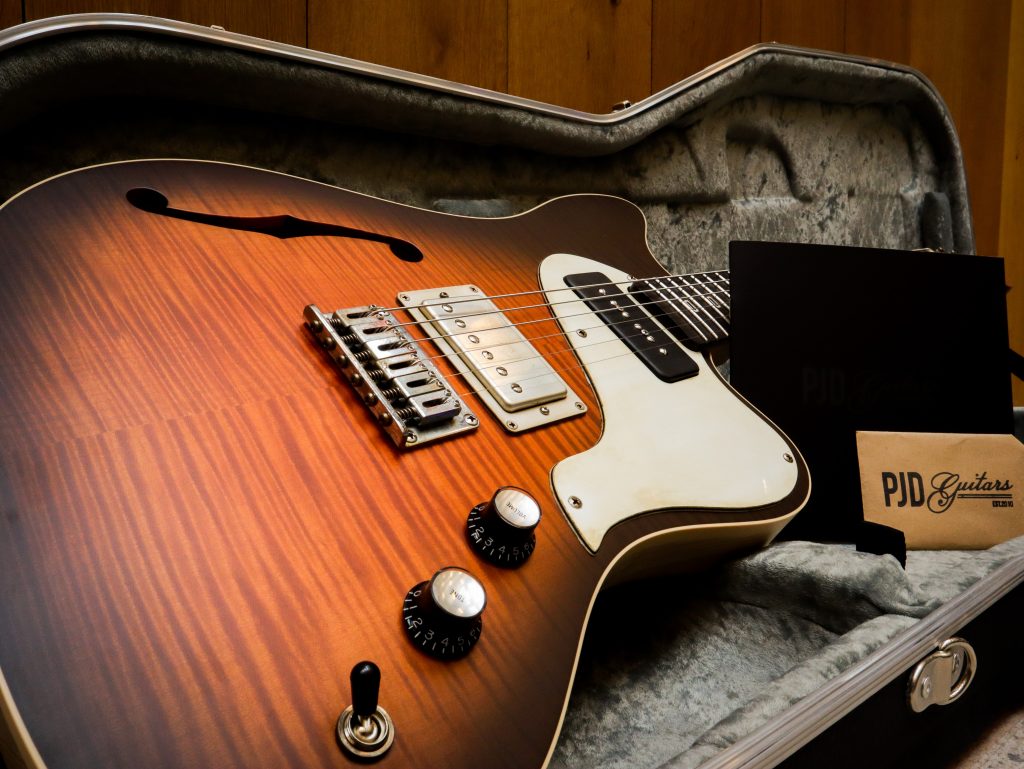How does it sound
PJD Guitars, British rock and roll guitars.
The British are back and PJD Guitars is leading the invasion
The new British invasion has arrived. Precisely; the country that brought us the Beatles, Oasis and Motorhead and from where Marshall and Vox attacked our hearing. But name a British guitar brand with the same legendary history? Look, then it gets quiet. Time to fill that gap. And that’s exactly what PJD Guitars does. With a series of timeless and super inspiring guitars with a solid rock & roll character.
Like a new friend you’ve known all your life
Guitarists are like people, they stick to what they know and are always looking for something new. In the store we regularly hear guitarists say that they want something completely different than what they have now. They then start in good spirits with trying out the guitar models that are new to them. To take their trusted model (of which they already have a few at home) from the wall after a while and then sigh ‘yes, this is like coming home’. Not infrequently, the trusted model is still chosen, in a slightly different variant. And that’s fine of course because it’s about the click you make with the guitar.
As a guitar builder you therefore want to deal with innovation in a dosed manner. Radical innovation will bring you reviews but no sales. The challenge for every luthier is therefore to add something and at the same time be familiar and recognizable. The PJD models hit the nail on the head in that area. They are hybrid guitars in which various recognizable styles come back with a clear signature of their own. Fresh yet familiar.
The PJD signature
Characteristic of every PJD guitar are a recognizable body model, the screwed roasted maple neck with six on a side tuners, the sturdy matte finishes and great looks of the guitar. Pickups are supplied by the British company Cream-T. And with these basic ingredients, PJD has created a series of super inspiring guitars. There are three models, each available in three trim levels.
The Woodford
The first model, the Woodford, is strongly reminiscent of a hardtail Stratocaster with an HSS pickup configuration. The guitar looks a fraction smaller than a strat.
The Carey
You immediately associate the second model with a Les Paul. But the body shape deviates enough to have its own face. That’s also because of the flat front instead of the domed top we find on a Gibson les Paul. And the F-holes that PJD has on many models also add something to the vibe of this guitar.
The St John
The third model is the St John. This model seems to be the most original of the bunch. The guitar is loosely based on a jazz master but with a smaller body. Actually, it’s a bit between a jazz master and a mustang. Here too we find F-holes and on the more luxurious versions a beautiful cream binding, which makes it suddenly new and fresh.
Versions
All models are available in different versions. All models have the basic ingredients and are equipped with a number of upgrades depending on the version. In addition to the different implementation levels, you can choose whether or not to use an F-hole on all models.
Standard
The Standard models have an ash body and a matte, often transparent finish. Simplicity is key here. Under the finish you can clearly feel and see the wood grain. That gives the guitar something rural, especially with natural or black lacquer. PJD has a tasteful color palette in the Standard series. Two “regular” colors; Midnight Black and Aspen White and four contemporary pastel shades that would not look out of place in Ibiza.
Under the hood are Cream T pickups. Also a British brand that is causing a furore, especially because of their vintage PAFs and P90s. Both the Standard and Elite models have a Cream-T Eliminator humbucker in the bridge and a Cream-T PJD P90. The latter was specially developed for PJD by Cream-T.
Elite
On the Elite versions, the bodies are upgraded to swamp ash with a flamed maple top. The back of the guitar is natural. Beautiful swamp ash with a light blonde color with a satin finish. A cream colored binding makes it a complete picture. In this series PJD offers a larger color palette. You can choose from nine colors that are all sprayed with a light burst. This is possible in traditional burst versions such as the Cherry Burst and Cocoa Burst. But things get more exciting with Green Forrest Burst or the Highland Burst. It’s amazing how PJD uses these modern colors without being ‘wanted’. It’s like the light pours in, it looks fresh and fruity without losing any of the vintage rock and roll vibe. Let’s say Vincent van Gogh meets vintage guitars.
Limited
The most luxurious version is the Limited. These come with a mahogany body with a quilted maple top. This is the only PJD version where the top has a hi gloss finish. Another important upgrade compared to the Standard and Elite series is in the pickup choice. Here too we find the Cream-T P90 in the neck position, but in the bridge we find the Cream-T Scanner 1. These pickups were developed by the Scandinavian Thomas Nilsen. Thomas designs guitar pickups for serious guitarists and has a clientele that includes many big names.
In his design he uses a method he calls the “Oracle Pickup Scanner”. In doing so, he discovers ins-and-outs of the pickups from the old Bursts such as the Pearly Gates by Billy Gibbons or the Beast by Bernie Marsden. The Scan 1 humbucker is a replica of a pickup from a ’59 Les Burst. And it has that magical transparent thick humbucker tone.
Playing on the PJDs
Whichever PJD you take up, they all have a familiar feeling. This is mainly due to the matte finish and the roasted maple neck. By the way, that neck has a 25.5 inch scale length and that will particularly appeal to Fender players. Of course that also applies to the 6-on-a-side tuners. The neck profile is a nice C that barely changes over the length of the neck. The fingerboard has a compound radius, which runs from 10” to 12”. And that’s nice when you play chords and also nice when you want to hear faster work higher on the neck. The neck is attached to the body with four bolts and that gives just a little more strength and sustain than a traditional screw-down neck.
The Cream-T pickups give the guitar a nice thick tone both with a clean setting and with a more overdriven amplifier. But nowhere does it get muddy. The guitar responds well to the dynamics of your right hand.
Whether it’s because of the roasted maple neck or the minimal amount of finish on the body, you feel a lot of wood on the guitars. The fretwork is of excellent quality and that guarantees a low action for fast solo work.
The different Cream T pickup combinations turn out to be extremely useful in practice. In particular, the combination of a P90 and humbucker is quickly the favorite choice in our store. Certainly on the Carey, you get a guitar that is somewhere between a Les Paul and a Tele. We just call it a Tele on steroids. That the strings run through the body and the bridge certainly has a big part in that sound.
And thus…
PJD has paid attention to the essence of the guitar. It is a guitar without excessive frills. Moreover, PJD manages to create something new without alienating the traditional guitarist. Baas Kauffmann believes in it and has taken no fewer than twenty different guitars in the collection. Time to meet PJD at Kauffmann’s Guitar Store!






Hello there! I simply want to offer you a huge thumbs up for your excellent information you
have got right here on this post. I’ll be coming back to your site for more soon.